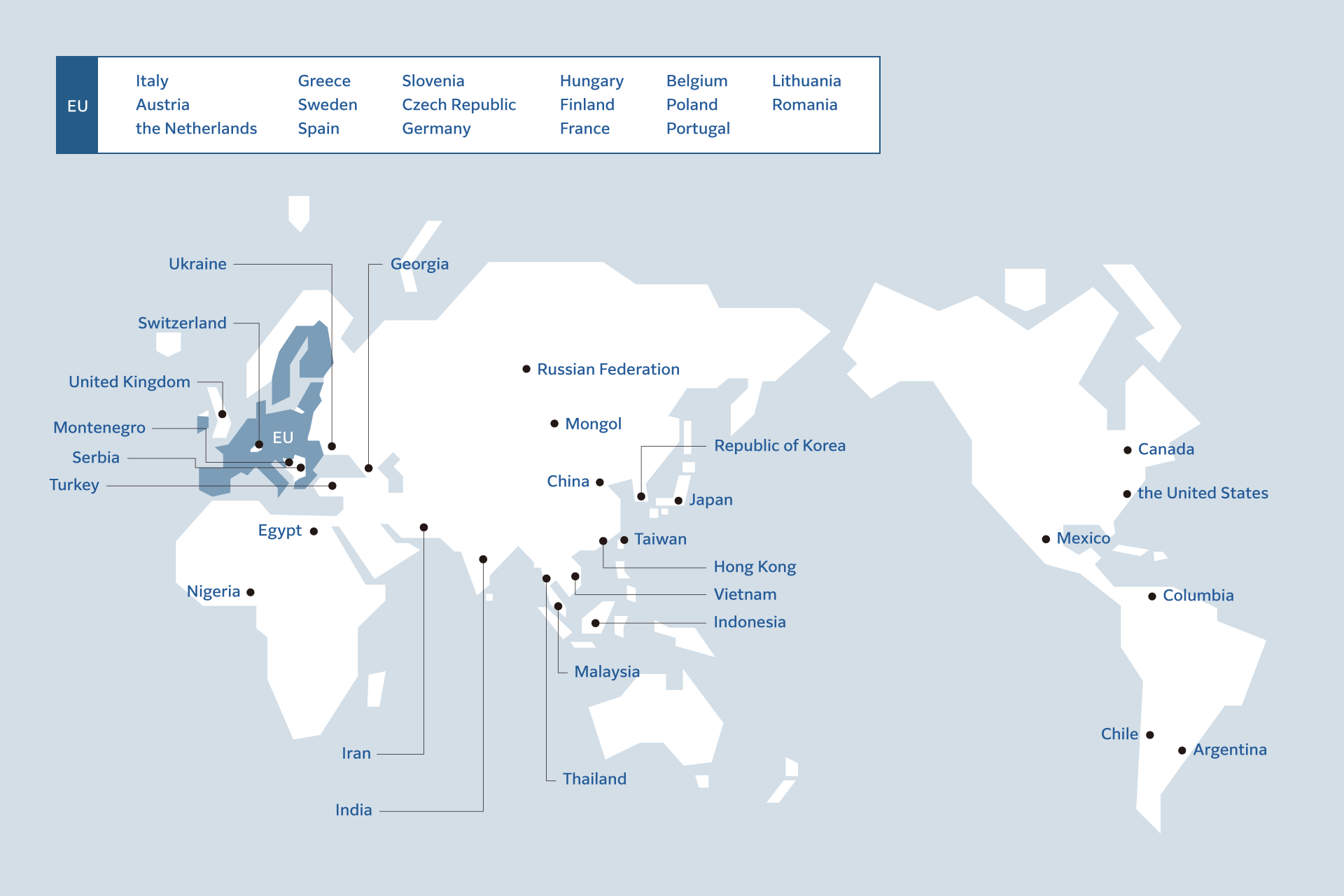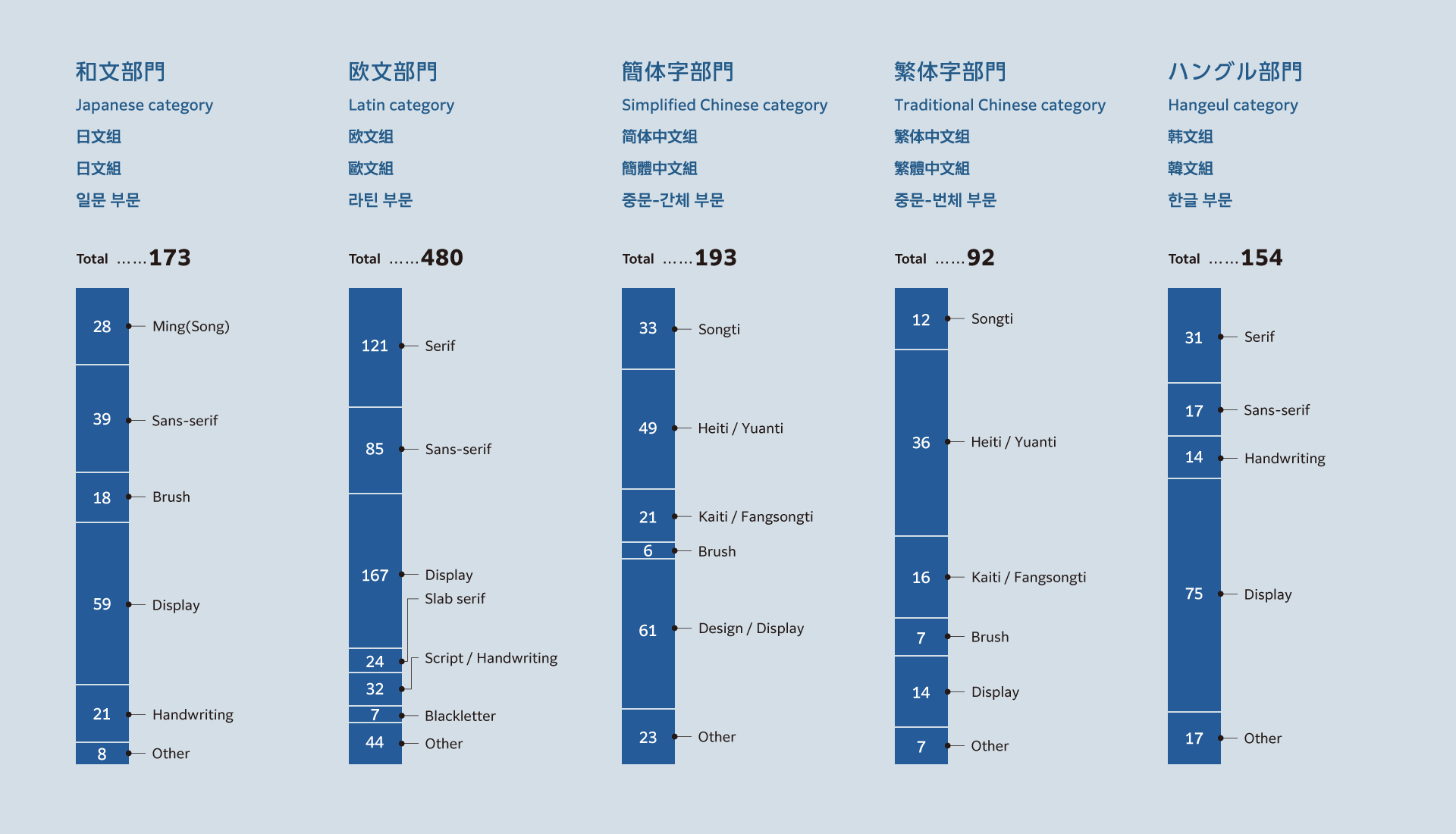Application Status / Process
Application Status
The Morisawa Type Design Competition 2024 is the fifth in the same series and the 12th since its predecessor, the “Morisawa Award International Typeface Design Competition” (1984). This time, works were accepted in five categories, including the existing Japanese and Latin categories, along with the newly added Simplified Chinese, Traditional Chinese, and Hangeul categories, and there were 1092 entries in total, including 173 in the Japanese category, 480 in the Latin category, 193 in the Simplified Chinese category, 92 in the Traditional Chinese category, and 154 in the Hangeul category.
Looking at the separate typeface categories, the proportion of display typefaces has increased in the two previous categories, with display and handwriting typefaces accounting for more than half of the total in the Japanese category, and display typefaces alone accounting for over 30% in the Latin category. In the Hangeul category, display and handwriting typefaces accounted for nearly 60%. On the other hand, in the Simplified Chinese and Traditional Chinese categories, body text typefaces such as Songti (serif typeface), Heiti (sans serif typeface), Yuanti (rounded sans serif style), and Kaiti (block style typeface) accounted for more than half of the total.
536 applicants submitted works, with 162 entries from Chinese-speaking regions, such as China, Hong Kong and Taiwan, and 150 entries from Republic of Korea, the highest number ever. There were 109 applicants from Japan, indicating the high level of regional interest in the newly established categories.
There were also a steady high number of applicants from Europe, for example, the United States and the United Kingdom, but this year there were first-time applicants from regions such as Southeast Europe and Asia, resulting in the competition receiving applications from 45 countries and regions. This reflects the growing global interest in typefaces.
As with the previous competition, “Fan Favorite” was held in addition to the Morisawa Award judging process. An online, public vote was held where anyone could participate, and 8959 votes were received in total.
* Font categories listed here are as declared by the applicants themselves.
Country and Regions of Applicants

Number of Entries by Category

Process
The judging panel for the Morisawa Type Design Competition 2024 was held
at the International Exhibition Center in Osaka and Morisawa’s corporate headquarters on November 26 and 27, 2024. Works were accepted over a three-month period, from May 14 to August 29, 2024, and a vote for the fan favorite was held from December 2 to 20 of the same year. The results of the Morisawa award, along with the results of the fan favorite, were posted on the competition’s official website on March 3, 2025.
The judges for each category were three type designers and graphic designers with a thorough knowledge of the language and typography of each category, as well as Matthew Carter and Cyrus Highsmith, who judged the Latin category last time, as emeritus judges. A total of 17 diverse judges representing various fields were on the panel.
The panel was conducted in multiple rounds from the initial judging to the final judging, with the applicants’ names kept secret. Throughout all categories the evaluation process focused on whether the works were original by the applicants.
In the Japanese category, the judges discussed works they felt that the applicants had spent time and effort on, rather than relying on digital tools to create typefaces. In the Latin category, the winning works were selected based on the theme, “What typeface is worthy of winning in 2024?” The judges engaged in thorough discussions, continuously refining the selection until the final round. In the Simplified Chinese category, the judges not only checked the style of the typefaces, but also their practicality, particularly in terms of whether they could maintain their readability when set in small point sizes. In the Traditional Chinese category, the judges exchanged opinions from their diverse professional standpoints, as typeface designers and users, and considered the overall balance of the winning works. In the Hangeul category, the judges were particularly conscious of the current social context in which characters are often viewed on screen. They also looked at works in other categories and had a conversation about the future of typefaces on a global scale.
As a result of this rigorous judging, a total of 40 internationally diverse winning works were selected, including one Gold, one Silver, and one Bronze Prize in each category, and five Honorable Mentions, at the end of the two-day judging panel.
